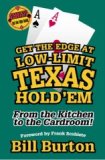
Get the Edge at Low Limit Texas Hold'em
Poker: Thinking Like a Pro
One of the things that separates the winning poker players from the losing players is they way they think when they are playing the game. Winning players take many factors into account before making
In order to be successful you need to know a little about the way your opponents play. The only way you will be able to determine the type of player you are up against is by studying them during the game. You should spend your time observing the other players when you are not involved in the hand.
Many players will sit in a game for hours and, if you asked them any specifics about their opponents, they would not be able to give you an answer. I make it a point to watch one or two players per hand. Any player who raises gets my attention. If he is in the hand until the end, I want to know exactly what hand he raised with. This will help me determine if he is a solid aggressive player, or a loose maniac trying to get some action. It is not too hard to determine who is playing tight and who is playing loose. If a raise comes from a tight player you should give it a lot more credence than if it comes from a loose maniac but if you haven’t been observing you won’t know who is who.
Reading Your Opponents
The skilled players have an uncanny ability to be able read their opponents. They think on a completely different level than many of the other players. I refer to this as the level of awareness and you can define a player into three basic levels.
Level one: What do I have?
Players at this level are looking at their two cards and reading the board trying to determine their best hand. They are wearing blinders and are only focused their hand. Depending on their skill level, they may also be thinking about their odds of making a hand if they are on a draw. This type of player is usually oblivious to any of the other players in the hand.
Level two: What does my opponent have?
Players at this level are paying more attention to the other players are the table. They are looking beyond their own hand trying to figure out what cards their opponent has. Based on betting or previous play they try to put their opponent on a range of hands and then determine their chances of winning the hand. They will make decisions based on what they think the other player has and their odds of winning the hand. With practice, a player can learn to read the other players at the table.
Level three: What does my opponent think I have?
Players at this level are trying to get inside the heads of their opponents. These players are expert at reading their opponents based on previous betting and actions they have made in the past. They do more than put a player on a hand. They take into account the playing style of their opponent such as whether they are tight or loose to further size them up. They try to determine what the other player thinks they have for a hand and how they can exploit it to their advantage.
While these levels are an over simplification, they do give you an idea of the degrees of skill that different players possess. Your ability to read other players can only be achieved with practice. You can practice each and every time you play as long as you concentrate on the game and watch the other players.

